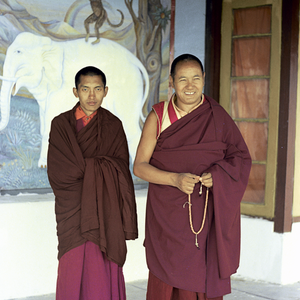
Fall 2013 Shamatha and the Bodhisattva Way of Life
B. Alan Wallace
Shamatha and the Bodhisattva Way of Life
- 93 Merging the Mind the Space and a Discussion of Kalachakra
Follwing the silent meditation, Alan gets to a few remaining questions, including one about his experience with Shambala and Kalachakra. A fascinating discussion and series of stories follows.
Meditation starts at: 0:05
26 October 2013, 3:41 am - 92 Merging Mind With Space and the Final Aphorisms of the Seven Point Mind Training
Before the silent meditation, Alan mentions a few points about Bodichitta.
After the silent meditation, we go back to the last few aphorisms of the Lo-Jong. We finish the Seven Point Mind Training with a quote from Dilgo Khyentse Rinpoche... and then go back to the very first aphorism of the Lo-Jong: the preliminaries.Meditation starts at: 03:21 (silent, not recorded)
25 October 2013, 2:10 pm - 91 Merging Mind With Space and How to Apply the Teachings in Daily Life
Before the session's meditation, Alan raises the issue of retreat and expedition for after the retreat is over.
After the meditation, there are a few questions about the relevance of doing short-term retreats in Dzogchen/Mahamudra/Vajrayana; is it worthwhile to chase after lamas, teachings and empowerments? How to live in the modern world after a long term retreat?Meditation starts at: 22:48 (silent, not recorded)
25 October 2013, 3:47 am - 90 Ultimate and relative bodhicitta and point seven of seven point mind training
Meditation front loading: The porousness of the mind. It is possible that influences can go both into and out from the mind. Like when praying to your guru and getting a response. Does the response come from the guru or from a deeper aspect of your own mind? All that matters is that the advice is taking you further along the path. So in practice of tong len, using the power of the mind, it is possible that we are providing genuine relief from suffering.
Post meditation: Covering the following aphorisms in the seven point mind training text. Cultivate three things without letting them deteriorate. Maintain three things inseparably. Meditate constantly on the distinctive ones. Do not depend on other factors. Now practice what is important. Alan also answers questions on why tulkus still require training in this life, the karmic responsibility of mental afflictions and if Shamatha is required for higher realisations.Meditation starts at: 11:30 (silent, not recorded)
24 October 2013, 11:55 am - 89 Merging Mind with Space
Silent session, followed by one question regarding the origin of people within a lucid dream. They all stem from the substrate consciousness. Even when lucid, they are not puppets on your string. As the relative dharmadhatu has no clear boundaries, it is porous so it is possible for a visitation to occur. There are accounts of people having visions of tara, padmasambhava etc. It is hard to say if these are actually tara or some figment of your imagination. But if a teaching leads to enlightenment, who else but a buddha could have taught them. The Theravada believe in metaphysical realism, the world is really out there, the self does not exist, but the world does. This is rejected by the mind only and middle way schools, there is no real world existing out there. So what was occurring on vulture's peak was pure perception. Just as you might walk right through Shambhala and not see it unless your body and mind are purified. So if the perfection of wisdom teachings are true, if teachings like the Kalachakra designed to lead to buddhahood in one life time, if they work, who else but a Buddha could have taught them.
Meditation starts at: (silent, not recorded)
24 October 2013, 6:21 am - 88 Ultimate and Relative Bodhicitta Meditation and the Seventh Point from Seven Point Mind Training
From the seventh point of Atisha's mind training: 'Adopt the three principle causes'
These causes are:
1. Following a qualified mentor
- Alan told the story of the first person to encounter the Buddha.
- Alan taught that we should see through the person and not reify them (or ourselves). Seeing all teachers equally whether it be as a emissary of the Budhha, like a Buddha or as a Buddha.
- If there is one with an inner heart connection, a root guru, see that guru in the centre and other teachers as emanations of that one.2. Devoting ourselves to all stages of the practice
- Have a panoramic vision of all the teachings but focus primarily where you have traction.3. Cultivate the outer and inner conditions for fruitful practice.
- One of our greatest freedoms is to choose our environment
- Inner conditions are the 5 faculties that when cultivated and developed become the 5 powers.Meditation started immediately with no 'front loading'
23 October 2013, 11:20 am - 87 Merging Mind with Space
This practice is a variation for shamatha without a sign.
The method this morning being balancing earth with sky: shamatha with support, with quasi support and without support.
Alan taught more on what rigpa is (and what it is not) and on the analogies with dream yoga.
Meditation starts at: 13:18 (silent, not recorded)
23 October 2013, 5:15 am - 86 Aspirational Meditation
Alan begins with two quotes from William James regarding aspiration.
The guided meditation is on developing your personal aspirations and the causes to fulfill them.
Discussion of Aspiring Bodhicitta and engaging Bodhicitta. Within engaging Bodhicitta, shepherd like Bodhicitta, Navigating Bodhicitta, and King like Bodhicitta.Alan continues with the 7th point of the Seven Point mind training.
Meditation starts at: 9:23
23 October 2013, 2:53 am - 85 Merging the mind with space
As you merge the mind with space, maintain a flow of knowing of the sheer absence of thought. It is a knowing of emptiness that can lead to an open expanse.
Meditation starts at: 6:40 (silent, not recorded)
23 October 2013, 2:51 am - 84 The Practices of Seven Point Mind Training
Tonight the meditation is front loaded by looking at two ways we can view the adversity that will no doubt effect us and those we see as belonging to us. Firstly, non lucidly with relative bodhichitta which still has an element of self centeredness, or secondly with ultimate bodhichitta, the view from the bardo, from emptiness or from rigpa.
After the meditation we move on to the practices of Seven Point Mind Training which look at the constructive things we can do to support our ongoing dharma practice. Here Alan focuses particularly on the practice of setting a motivation of Bodhichitta and dedicating.
Questions:
How can we help some one in the throws of anger?
Do we have to believe every sentient being has been our mother to practice Bodhichitta?
Clarification about the practice of Merging Mind With Space.
Meditation starts at: 19:40 (silent, not recorded)
21 October 2013, 11:40 am - 83 Return to Merging the Mind with Space
In this short session Alan front loads our week of meditation practice speaking of how we can rollback the layers of conceptual overlay to conceptual and then primal mentation - the first raw sense of presence different from space. This too can be melted away to the substrate consciousness.
Meditation starts at: 10:15 (silent, not recorded)
21 October 2013, 3:00 am - More Episodes? Get the App
Your feedback is valuable to us. Should you encounter any bugs, glitches, lack of functionality or other problems, please email us on [email protected] or join Moon.FM Telegram Group where you can talk directly to the dev team who are happy to answer any queries.
 The Berzin Archives Podcasts
The Berzin Archives Podcasts
 Lama Yeshe Wisdom Archive
Lama Yeshe Wisdom Archive
 Shambhala Publications
Shambhala Publications
 Study Buddhist Treatises with Thubten Chodron - Bhikshuni Thubten Chodron
Study Buddhist Treatises with Thubten Chodron - Bhikshuni Thubten Chodron
 The Berzin Archives Podcasts
The Berzin Archives Podcasts
 Fall 2014 Shamatha, Vipashyana, Dream Yoga
Fall 2014 Shamatha, Vipashyana, Dream Yoga